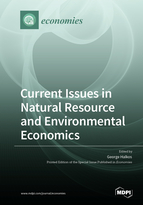Current Issues in Natural Resource and Environmental Economics
A special issue of Economies (ISSN 2227-7099).
Deadline for manuscript submissions: closed (31 March 2021) | Viewed by 59785
Special Issue Editor
Interests: applied statistics and econometrics; simulations of economic modelling; environmental economics; applied micro-economic with emphasis in welfare economics; air pollution; game theory; mathematical models (non-linear programming)
Special Issues, Collections and Topics in MDPI journals
Special Issue Information
Dear Colleagues,
The issue of interrelationship between economic growth, efficient use of natural resources, and sustainability has been the subject of thorough research and of great interest to economists, researchers, and policy makers. Knowledge of the actual causality direction between sustainability, efficiency, and growth has important implications for modeling environmental economics policies. The various serious environmental problems demand urgent attention and planning of adequate policies towards sustainability. Development of new economic and environmental policies and use of new econometric, operational research mathematical and statistical techniques provide enough space for further research. In order to fill this gap in the literature, this call for papers provides an analysis with special attention to the potential role of efficient use of natural resources, appropriate planning of environmental policies, and fulfilment of a sustainable economic growth. The applied theoretical and analytical contributions are expected to provide guidance to policymakers and government officials in designing new policy scenarios for the investigation of sustainable environmental and resource economics policies. The empirical contributions should provide evidence to support and inform current policy debates worldwide. Contributions will be selected through a refereeing process consistent with the standard reviewing process of Economies, to ensure original contributions of the highest quality are included.
Toward these goals, studies are solicited addressing the following research questions, including but not limited to:
- Economic growth and environment: environmental problems (climate change, ozone depletion, acid rain, biodiversity, desertification);
- Air and water pollution;
- Impact of pollution on health;
- Health economics;
- Waste management;
- Natural resources management;
- Population economics;
- Environmental policy tools;
- Renewable energy sources;
- Business and sustainable development;
- Sustainable transport;
- Sustainable tourism;
- Urban and regional development.
Prof. Dr. George Halkos
Guest Editor
Manuscript Submission Information
Manuscripts should be submitted online at www.mdpi.com by registering and logging in to this website. Once you are registered, click here to go to the submission form. Manuscripts can be submitted until the deadline. All submissions that pass pre-check are peer-reviewed. Accepted papers will be published continuously in the journal (as soon as accepted) and will be listed together on the special issue website. Research articles, review articles as well as short communications are invited. For planned papers, a title and short abstract (about 100 words) can be sent to the Editorial Office for announcement on this website.
Submitted manuscripts should not have been published previously, nor be under consideration for publication elsewhere (except conference proceedings papers). All manuscripts are thoroughly refereed through a single-blind peer-review process. A guide for authors and other relevant information for submission of manuscripts is available on the Instructions for Authors page. Economies is an international peer-reviewed open access monthly journal published by MDPI.
Please visit the Instructions for Authors page before submitting a manuscript. The Article Processing Charge (APC) for publication in this open access journal is 1800 CHF (Swiss Francs). Submitted papers should be well formatted and use good English. Authors may use MDPI's English editing service prior to publication or during author revisions.






